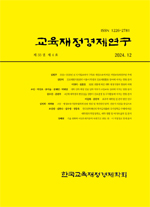한국장학재단의 학자금대출과 국가장학금 수혜에 따른 대학생의 학업성취도, 대학 생활 및 여가와 삶의 질 분석
Student Loans vs. National Scholarships: College Students’ Academic Achievement, University Life, Leisure, and Quality of Life
- 한국교육재정경제학회
- 교육재정경제연구
- 제33권 제4호
-
2024.12189 - 216 (28 pages)
-
DOI : 10.46967/jefe.2024.33.4.189
- 164

본 연구는 학자금 지원이라는 같은 목표 하에 방식은 다르게 운용되고 있는 학자금대출과 국가장학금 제도에 대한 종합적인 정책 효과를 대학 성과와 대학 생활 및 여가와 삶의 질을 중심으로 비교하고자 했다. 이를 위해 한국교육고용패널조사Ⅱ(Korean Education and Employment Panel II, KEEPⅡ) 3~6차년도 자료를 활용하였고, 한국장학재단에서 학자금대출과 국가장학금을 수혜한 집단을 식별한 뒤, 두 집단 간 이질성을 통제하기 위해 경향점수매칭, 이원고정효과분석을 실시하였다. 아울러, 본 연구는 비처치집단에 대한 평균처치효과(Average Treatment Effect on the Untreated, ATU)를 분석하기 위해 한국장학재단의 학자금대출 수혜 집단이 국가장학금을 받게 된다면 나타날 효과를 추정하고자 했다. 분석 결과, 대학 학업 성과와 대학 생활 변인에서는 국가장학금과 학자금대출 집단 간 통계적으로 유의한 차이가 없었지만, 학생의 건강 및 삶의 질 관련 종속변수에서는 국가장학금 수혜 집단에서 통계적으로 유의한 수준의 정적 효과가 나타났다. 즉, 국가장학금을 받게 된 학생들은 아침식사를 더 잘 챙겨 먹으며, 평일 여가시간, 운동시간, 수면시간 등의 가용시간이 늘어나고, 행복도가 높아짐을 확인할 수 있었다. 본 연구는 학자금 지원과 학생의 건강과 삶의 질에 대해 주목하였다는 점에서 내용적 의의가 있으며 연구방법론적으로는 경향점수매칭의 대조군을 실제 정책 대상에 가까운 집단으로 설정하여 두 가지 학자금 지원 정책의 효과를 비교한 것이 특징이라 할 수 있다. 이를 토대로 향후 정책적 시사점 도출의 필요성 및 후속 연구문제를 제언하였다.
This study aimed to compare policy effects of two main pillars of national financial aid programs—student loans and national scholarships—operating under the shared objective of financial assistance for higher education but in different ways, focusing on university students’ outcomes, student life, leisure, and quality of life. We utilized data from the KEEP II covering 2018~2021. The study identified groups receiving student loans and national scholarships through the Korea Student Aid Foundation (KOSAF), employing propensity score matching (PSM) to control for sample selection bias. A two-way fixed effects (FE) analysis was conducted using four years of data to account for individual-specific and time-specific effects. Furthermore, this study estimates the Average Treatment Effect on the Untreated (ATU) by predicting the effects on the group that received student loans if they were to receive national scholarships. The analysis yielded the following findings: while there were no statistically significant differences between the national scholarship and student loan groups in terms of academic performance and university life variables, the scholarship recipients exhibited a statistically significant positive effect on health and quality of life-related dependent variables. In other words, students who received national scholarships were more likely to have regular breakfast, increase their weekday leisure time, engage in more physical exercise, and enjoy better sleep quality, and increase happiness. The significance of this study lies in its focus on the relationship between financial aid, student health, and quality of life. Methodologically, by setting the control group for propensity score matching to resemble the actual policy target group, thereby facilitating a comparison of the effects of the two financial aid policies. Based on these findings, the study suggests policy implications.
Ⅰ. 서론
Ⅱ. 이론적 배경
Ⅲ. 연구방법
Ⅳ. 분석결과
Ⅴ. 결론 및 논의
참고문헌
(0)
(0)